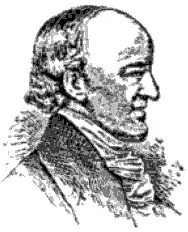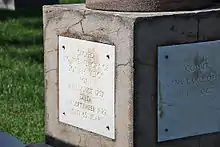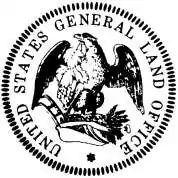Josiah Meigs
Josiah Meigs (August 21, 1757 – September 4, 1822) was an American academic, journalist and government official. He was the first acting president of the University of Georgia (UGA) in Athens, where he implemented the university's first physics curriculum in 1801, and also president of the Columbian Institute for the Promotion of Arts and Sciences. His grandson was Major General Montgomery C. Meigs.
Josiah Meigs | |
|---|---|
 | |
| President of the University of Georgia | |
| In office 1801–1810 | |
| Preceded by | Abraham Baldwin |
| Succeeded by | John Brown |
| Personal details | |
| Born | August 21, 1757 Middletown, Connecticut |
| Died | September 4, 1822 (aged 65) Washington, D.C. |
| Children | Clara Meigs |
| Alma mater | Yale University |
| Signature | |
History
Meigs was the 13th and last child of Jonathan Meigs and Elizabeth Hamlin Meigs.[1] His older brother was Return J. Meigs, Sr., whose son (Josiah's nephew) was Return J. Meigs, Jr., who served as a United States Senator and Governor of Ohio.
After graduating from Yale University in 1778 with a Bachelor of Arts (B.A) degree, Meigs studied law and was (from 1781 to 1784) a Yale tutor in mathematics, natural philosophy and astronomy. Yale class of 1778 included Noah Webster, Joel Barlow, Oliver Wolcott, Uriah Tracy, Zephaniah Swift, Ashur Miller, and Noah Smith.[2] He was admitted to the bar in New Haven, Connecticut, in 1783, and served as New Haven city clerk from 1784 to 1789. During this period he established and published The New Haven Gazette (later known as The New Haven Gazette and the Connecticut Magazine). During his time as Editor he published, on 16 November 1786, General George Washington’s Papers concerning "The Asgill Affair" of 1782. When Captain Charles Asgill received a copy of this edition, in London, he immediately wrote a letter of rebuttal to the Editor, on 20 December 1786. Meigs decided not to publish Asgill’s letter, thereby depriving history of a balanced account of these events. Two hundred and thirty three years later this was rectified by The Journal of Lancaster county's Historical society VOL. 120, NO. 3 Winter 2019 [3] which has devoted the entire issue to this subject. In 1788 Meigs published the first American Medical Journal.[4]
Career
In 1789 Meigs left New Haven for St. George, Bermuda, where he practiced law and was involved in defending the owners of U.S. vessels that had been captured by British privateers.[4] In 1794 he returned to the United States and took the chair of mathematics and natural philosophy at Yale. As a Republican, he was in conflict with the Federalists who ran Yale.[5] He taught there until 1801 when he was chosen as the first acting president of the University of Georgia (UGA) in Athens. His salary at Georgia was fixed at fifteen hundred dollars, and he was given four hundred dollars in moving expenses for his family.
At Georgia, Meigs implemented the university's first physics curriculum in 1801. He resigned as president on August 9, 1810, after clashing with the Board of Trustees for the University; however, he continued on in the position of Professor of Mathematics, Natural Philosophy and Chemistry for one more year. John Brown was elected by the Board of Trustees as the new president.
After his academic career at UGA, Meigs was appointed Surveyor General by President James Madison in 1812, residing in Cincinnati, Ohio.[6] He then accepted an appointment as Commissioner of the United States General Land Office in Washington, D.C., in 1814. During his tenure at the U.S. Land Office, under Jefferson, he instituted the nation's first system of daily meteorological observations at the land offices throughout the country which evolved into the National Weather Service .
Societies
During the 1820s, Meigs was a member of the prestigious society, Columbian Institute for the Promotion of Arts and Sciences, who counted among their members former presidents Andrew Jackson and John Quincy Adams and many prominent men of the day, including well-known representatives of the military, government service, medical and other professions.[7]
Meigs was also at one point, the president of the Columbian Institute. He was also one of the original corporators and trustees of Columbian College (now George Washington University), and professor of experimental philosophy there.
Personal

In 1782, Meigs married Clara Benjamin. Their son Henry Meigs served in the U.S. Congress. Another son, Charles Delucena Meigs, became a prominent obstetrician. Their daughter Clara married John Forsyth, U.S. Secretary of State under Andrew Jackson and Martin Van Buren.
Meigs died on September 4, 1822 and was originally buried in Holmead's Cemetery in Washington, D.C. The cemetery was disbanded and the graves removed, so he was reinterred in Arlington National Cemetery in 1878 in the lot of his grandson, Major General Montgomery C. Meigs.
Legacy
He is remembered at the University of Georgia in the name of the university's highest teaching honor. The university annually recognizes up to five faculty members with the Josiah Meigs Distinguished Teaching Professorship. The city of Meigs, Georgia, is named in his honor as is Meigs Street in Athens, Georgia.[8]
Notes
- "Archived copy". Archived from the original on August 30, 2007. Retrieved November 26, 2008.CS1 maint: archived copy as title (link), Meigs Family History and Genealogy website
- Meigs 1887 : 10
- "The Journal of Lancaster county's Historical society Vol. 120, No. 3 Winter 2019".
- Josiah Meigs Archived 2009-02-06 at the Wayback Machine by Rick Meigs, Meigs Family History and Genealogy website
- Meigs 1887 : 38-43
- Meigs 1887 : 62
- Rathbun, Richard (1904). The Columbian institute for the promotion of arts and sciences: A Washington Society of 1816-1838. Bulletin of the United States National Museum, October 18, 1917. Retrieved June 20, 2010.
- Krakow, Kenneth K. (1975). Georgia Place-Names: Their History and Origins (PDF). Macon, GA: Winship Press. p. 145. ISBN 0-915430-00-2.
Sources
- History of the University of Georgia, Thomas Walter Reed, Imprint: Athens, Georgia : University of Georgia, ca. 1949
- Arlington National Cemetery headstone and short bio for Josiah Meigs
- New Georgia Encyclopedia entry for Josiah Meigs
- History of Meigs Hall on the UGA campus
- Meigs, William Montgomery (1887). Life of Josiah Meigs. Philadelphia.
External links
- William M. Meigs, Life of Josiah Meigs, Philadelphia (J.P. Murphy, printer), 1887. 132 pages.
- . Appletons' Cyclopædia of American Biography. 1900.
![]() Media related to Josiah Meigs at Wikimedia Commons
Media related to Josiah Meigs at Wikimedia Commons

